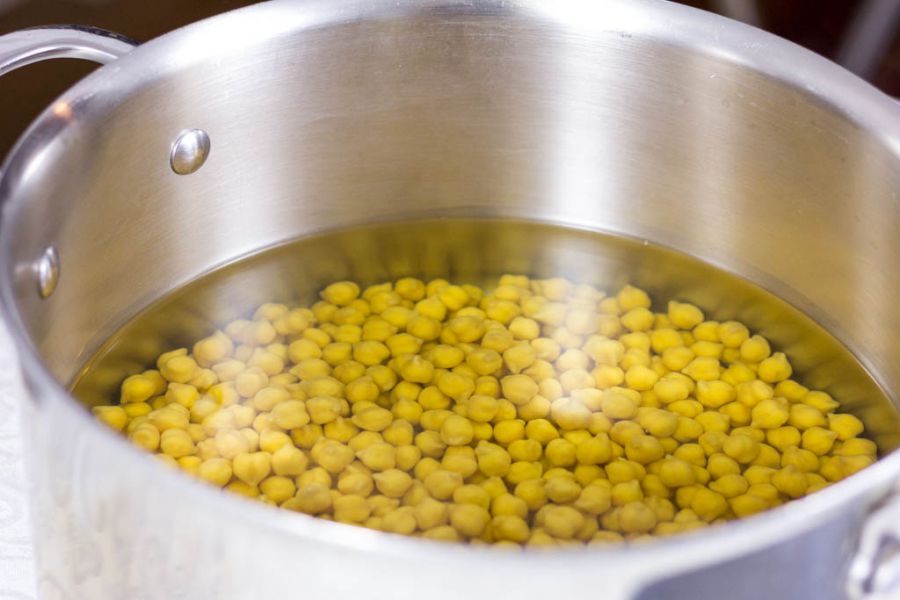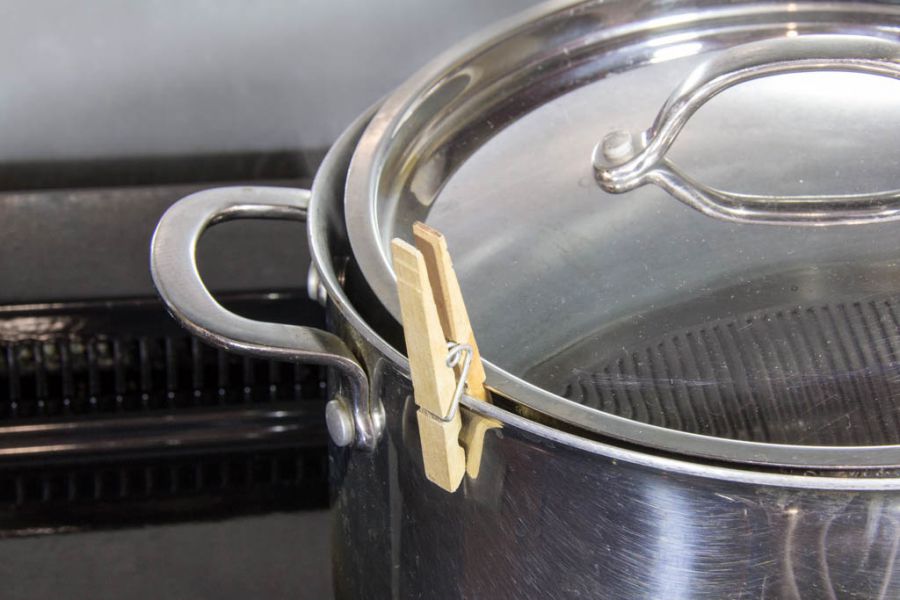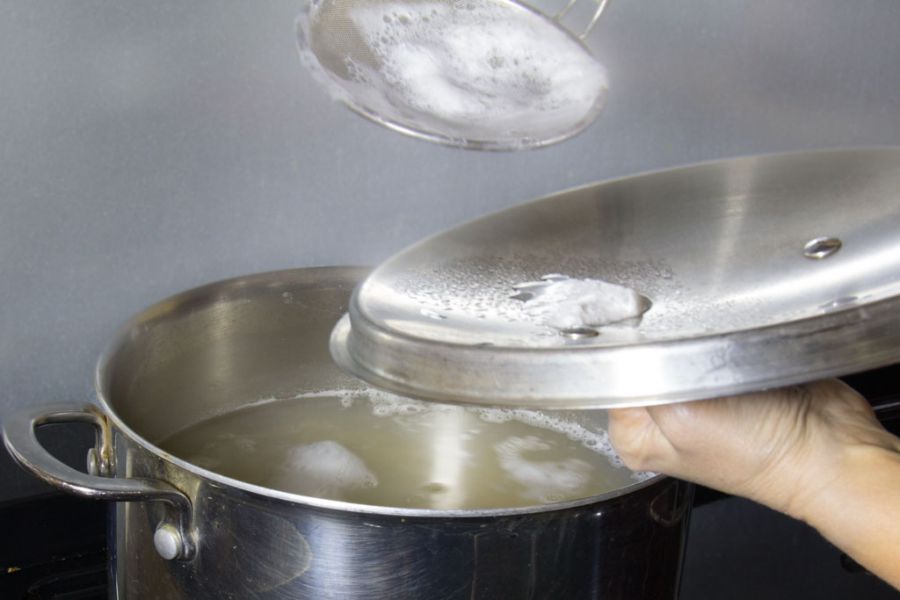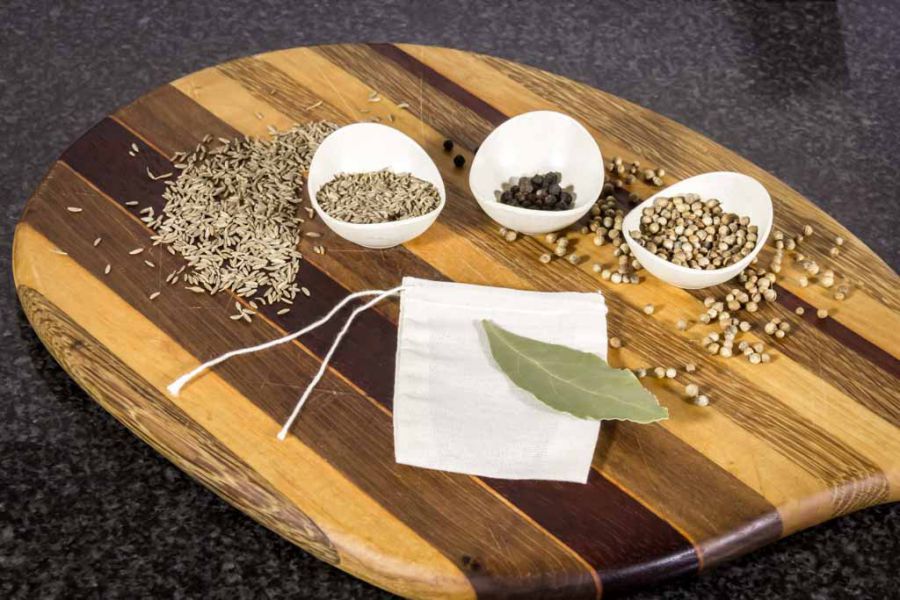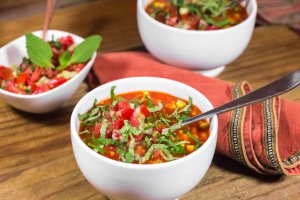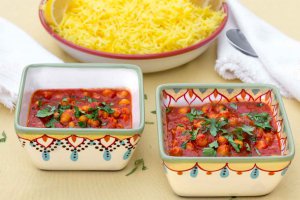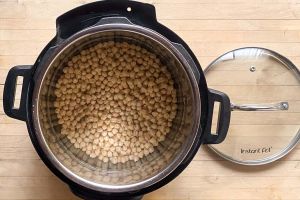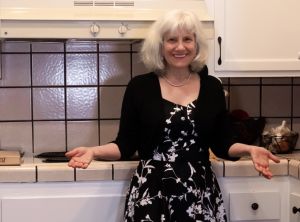Cooking Dried Chickpeas & the Resulting Chickpea Stock
Stovetop method for Cooking Dried Chickpeas (aka Garbanzo Beans)
More than any other bean, cooking dried chickpeas (garbanzos) at home, taste so much better than canned or jarred.

Chickpeas cooked from dried, have a nutty taste with a slight sweetness. This is the stovetop method of cooking them at home. The stovetop method allows you to simmer them up to the exact tenderness or firmness that works best for your dish. And, there is the huge bonus of getting the resulting chickpea stock that is so good in soups, sauces and stews. The stock is worth it alone to take a little extra time for doing at home. For the Instant Pot method see Cooking Dried Chickpeas in the Instant Pot.
For those of us who eat a lot of beans, you can save quite a bit of money too by cooking them at home. Dried beans are about 1 quarter the price of canned beans. One pound of dried chickpeas cooks up to 6–7 cups, the equivalent of 4-5 cans.
Finding Good Chickpeas
It is important to get the freshest dried chickpeas available. Chickpeas that are old don’t cook up as well, sometimes have a gritty, chalky texture even when completely cooked through, and take much longer. The fresher the chickpeas are, the faster and more evenly they cook. Mediterranean and middle-eastern markets are really good sources, since chickpeas are a staple in that part of the world. They are also typically less expensive. Health food stores, local coop stores and grocery stores with a high turnover on bulk goods are also good sources.
Soaking Dried Chickpeas
Over the years of cooking dried chickpeas and experimenting with soaking methods, or not soaking, I have found the “overnight” soaking method gives the best result in the final cooked chickpeas. Overnight translates into a minimum of 8 hours and no more than about 24 hours, but 16 hours seems to be the charm.
Overnight soaking helps the chickpeas to cook more evenly and have a creamier texture. The quick soak method of bringing the chickpeas to a boil for a couple minutes, then letting rest for 1–2 hours doesn’t give quite as good of results; the chickpeas take longer to cook and sometimes are somewhat tough or gritty even when fully cooked. The same is true for not soaking at all.
Prior to soaking the chickpeas, sort through for any foreign particles and rinse the chickpeas well. Usually I use the same pot to soak the chickpeas as I will for the cooking. Add the chickpeas to the pot and 3 times the amount of filtered water. After 8 hours of soaking, drain the water, add more fresh filtered water and leave for another 8 hours (up to a total of 24 hours) before cooking. Then drain that water and add fresh water to start the cooking. (See the recipe card with instructions below).
How to Cook Dried Chickpeas to the Right Doneness for Your Dishes
Cooking from dried also has the advantage of cooking to the desired texture. Firmer beans are good for chickpea dishes where the beans stay whole, while the softer version is perfect for when you will be blending the beans, like in hummus. For a softer bean, simmer longer checking about every 10 minutes after the initial 20 minutes until done to the tenderness you like. You can do both in one batch. Cook to the firmness you like for your dish and pull the amount needed out with a strainer. Leave the amount you want softer in the cooking water and continue simmering until the beans reach the softness for hummus or other blended bean dishes and condiments.
Skim the Foam
The Resulting Chickpea Stock
One of the perks of cooking dried chickpeas from scratch, besides the wonderful taste and cooking versatility, is the chickpea stock that comes from cooking the chickpeas. Unlike vegetable stocks, chickpea stock develops a gelatin-like viscosity, and when reduced gets even thicker. This is perfect for sauces that you want to reduce or thicken.
For a thicker chickpea stock “aquafaba” that will be better for the egg white type foam or thickening sauces, continue to simmer the chickpea stock to reduce by 1/3 to 1/2. Chickpea stock reduced to aquafaba is great for nut-based cream sauces too. It whips up to a thick foamy consistency and it turns white in color much like egg whites.
I often add a spice bag with the spices typically used in the chickpea dishes I make during the cooking to give a fuller flavor, but a spice bag is not necessary to achieve a good stock. The chickpea stock that results from the cooking water is really good in pilafs, soups, sauces and of course bean dishes. The spice combination used in this recipe is ideal for the Moroccan Spiced Chickpeas. But, if you don’t yet know what you will use the chickpea stock for, leave out the spice bag so you can use for any dish.
Storing Cooked Chickpeas and Chickpea Stock
Cooked chickpeas can be refrigerated for up to four days. Glass jars work best for storing in the refrigerator for both the cooked chickpeas and the chickpea stock. Chickpea stock can be stored in the refrigerator for up to five days in the refrigerator and in the freezer for about three months in a freezer-safe container.
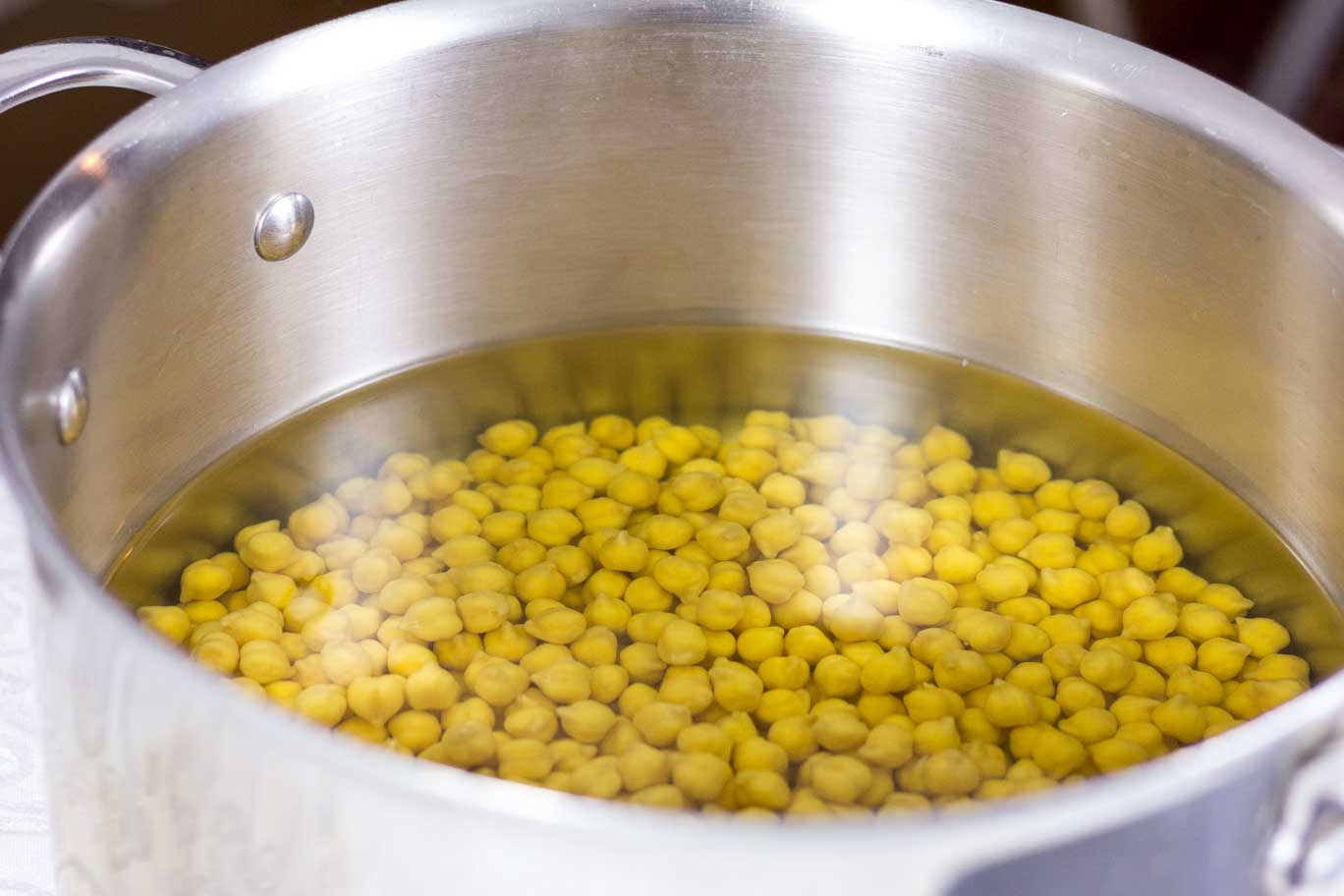
Tools Used in this Recipe
- large prep bowl or pot to soak the chickpeas
- colander
- large stock pot or Dutch oven
- spice bag or tea ball
- strainer or large slotted serving spoon
- storing containers
Ingredients
- 1 lb dried chickpeas also called garbanzo beans
- 8 cups or so of filtered water for soaking
- 10 cups filtered water for cooking Add more water as needed. Add I cup every 20 minutes of time over 40 minutes.
Spice Bag: (optional)
- 1 tbls whole cumin seeds
- 1 tbls whole coriander seeds
- 15 black peppercorns
- 2 bay leaves
Instructions
- Check for non-bean particles like small pebbles that sometimes get in along with the beans. Pour the chickpeas in a large bowl or pot that you will use to cook them in.1 lb dried chickpeas also called garbanzo beans
- Fill the bowl or pot with tap water and rinse the beans and drain the water, repeat 2–3 times,
- Add filtered water and the drained chickpeas in the large prep bowl or pot, cover and let soak for 8–16 hours, changing the water after 8 hours. A little foam may rise to the top.8 cups or so of filtered water for soaking
- Drain the beans in the colander and rinse.
- Heat a large stock pot or Dutch oven and add the beans in the pot plus the 10–12 cups or so of filtered water. The water to chickpea ratio should look about 4:1. Bring to a boil.10 cups filtered water for cooking
- Meanwhile, fill the spice bag with the spices if using and set aside.1 tbls whole cumin seeds, 1 tbls whole coriander seeds, 15 black peppercorns, 2 bay leaves
- As the water starts to boil, foam is released from the chickpeas. Skim off any foam that rises to the top and discard. Let boil again and keep skimming until no foam is left, 2 to 3 times.
- Once the water is clear of foam and boiling, add the spice bag if using.
- Cover the pot with the lid, but not all the way. If completely covered it will boil over and the liquid will spill all over the stove top. I use a clothes pin on the side of the pot to keep the lid slightly off the pot. Clothes pins have a groove that the lid can rest on so the lid stays in place (see the photo above).
- Let the chickpeas simmer at a rolling boil until done. Check at least 3 beans as they can vary in doneness. Chickpeas can cook to the right tenderness in as little as 20 to 30 minutes minutes and up to 90 minutes after water has come to a boil. Check at 20 minutes just in case. The average time is 40 minutes for the chickpeas I purchase regularly from a local Mediterranean market. If more than 40 minutes is needed add about 1 cup of water and check again in about 20 minutes.
- Once the chickpeas are the tenderness you like, lift them out with a strainer or large slotted spoon and they are ready for use in your dish or dishes. The chickpeas will stay good to use in the refrigerator for up 4 days.
- Let the remaining chickpea stock cool before storing in the refrigerator or freezer. Date your storing containers and store and/or use in your dish. Tip: if using a felt pen or sharpie to date the outside of the jar, write the date on the jar before adding the stock so the jar is dry.





